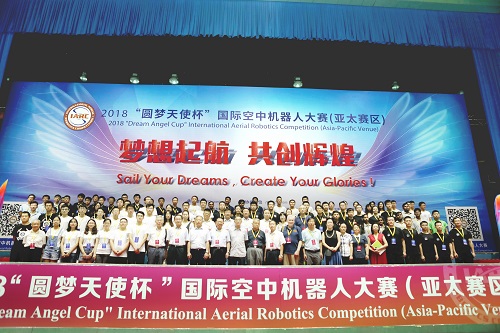From August 25th to 27th, 2018, the 2018 "Dream Angel Cup" International Air Robot Competition (Asia Pacific Division) was successfully held at Beijing University of Aeronautics and Astronautics.
 |
| |
The competition was jointly sponsored by the International UAV System Association, the Chinese Aviation Society, the China Artificial Intelligence Society, the China Automation Society, the Beijing University of Aeronautics and Astronautics, and the China Aviation Education Association. The International UAV System Association established a bonus, and the China Aviation Society did not. Driving Aircraft Systems Committee, China Aviation Society Guidance, Navigation and Control Branch, National Key Laboratory of Aircraft Control Integration Technology, China Automation Society Unmanned Aircraft Autonomous Control Professional Committee (funding), China Artificial Intelligence Society Science Committee, Beijing Airlines Co-organized by the Institute of Space Science and Beijing Xiaofeishou Education Technology Co., Ltd., Beijing Yuanmeng Angel Navigation Technology Co., Ltd.
After the technical reply session on August 25th, on August 26th, 13 university teams, 134 athletes, referees and guests from the international Asia-Pacific region gathered at the Beijing University of Aeronautics and Astronautics Gymnasium to attend the opening ceremony. Professor Zhang Juen, executive director of the China Aviation Society, and the founder of the competition, Professor Robert C. Michelson of Georgia Tech University and Professor Yang Fangchun, executive vice president of the China Artificial Intelligence Society, delivered speeches respectively. Professor Liu Gaoxuan, Honorary Chairman of the China Aviation Society, Professor Wang Rongqiao, Assistant to the President of Beihang University, General Wei Gang, Honorary Director of the China Aviation Society, Professor Lu Jinhu, Dean of the Beijing University of Automation, and Professor Wang Yingxun, Dean of the Beihang Institute of Unmanned Systems, attended the opening ceremony. After the opening ceremony, a wonderful drone cluster formation performance was performed.
 |
| |
 |
| |
This year is the fifth and final year of the seventh-generation mission, and the year of the eighth-generation mission. Due to the technical difficulty, the two divisions in China and the United States have not been able to complete the seventh mission in the past four years - "Airborne Shepherd Dog Action". According to the rules of the game, the air robot is a "shepherd dog". In the competition venue, 10 randomly-moving ground robots are "sheep", and 4 randomly-moving ground robots are "wolves". The airborne robot ("Shepherd") will have more than 4 ground robots ("Sheep") trapped in the air within 10 minutes by blocking the "sheep" in the air ("Sheep"). Sheepfold"), completed the first phase of the seventh-generation mission, referred to as the 7a mission. Compared with last year, this year's participating teams have made great progress in dynamic multi-target tracking and positioning, autonomous situation judgment and decision making, real-time mission planning, indoor optical flow and visual navigation, and flight control. For example, the Zhejiang University team successfully Drive the three "sheep" out of the circle.
After fierce competition, some outstanding teams represented by Zhejiang University won a historic breakthrough this year. The ZMART team of Zhejiang University won the annual champion of the 7th generation in 2018 and won the prize of 20,000 US dollars. The Egret of Xiamen University won the award. In the second place in 2018 and received a prize of 6,000 US dollars, the HITCSC team of Harbin Institute of Technology won the third place in the year and won a prize of 4,000 US dollars. The Naval Aviation University Zhiying team won the best mission planning award, Beijing University of Aeronautics and Astronautics Suiyuan-X team Received the Best System Control Award, Nanjing University of Aeronautics and Astronautics representative Xiangyang and the team won the best system navigation award, Civil Aviation University Civil Drone team won the system design award, Sun Yat-Sen University Air Robot Team won the Innovation Design Award, Ningxia University Eagle The eye team won the Best Progress Award and the team of the Hindustan University-KCG Technical College won the Team Culture Award.
 |
| |
The referee team finally selected three award-winning teams--Beijing University of Aeronautics and Astronautics-Yuyuan-Y team won the best human-computer collaboration award for the eighth-generation mission with the first place score and won 5,000 yuan prize, Harbin Institute of Technology The HITCSC team won the Best Technology Achievement Award and received a $2,000 prize. The Indian Institute of Technology's Mumbai team won the Best Performance Award.
The referee team finally selected three award-winning teams--Beijing University of Aeronautics and Astronautics-Yuyuan-Y team won the best human-computer collaboration award for the eighth-generation mission with the first place score and won 5,000 yuan prize, Harbin Institute of Technology The HITCSC team won the Best Technology Achievement Award and received a $2,000 prize. The Indian Institute of Technology's Mumbai team won the Best Performance Award.
 |
| Winning team photo |
Founded in 1991, the International Air Robot Competition was sponsored by Professor Robert of Georgia Tech and supported by the International Association of Unmanned Aerial Vehicle Systems (AUVSI). It was held simultaneously in Europe, the United States and Asia Pacific. The competition has been going through 27 years, and it is an intelligent high-tech competition task that is gradually improved from automatic to autonomous control.
In the 27 years since the competition was founded, MIT, Stanford University, Carnegie Mellon University, Berlin Institute of Technology, Tsinghua University, and Zhejiang University have completed seven intelligent high-tech competitions from automatic to autonomous control. The academic research and practice of UAV design, navigation and control are closely combined to cultivate the teamwork ability and innovation ability of the participating students. It has become an influential postgraduate and university student science and technology innovation event brand in the international colleges and universities.

